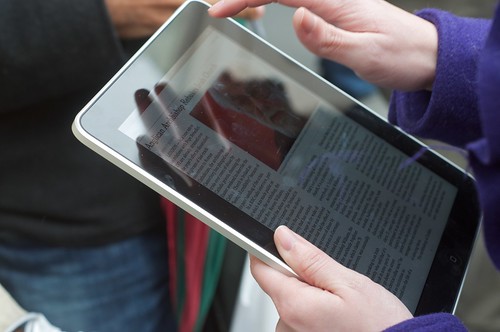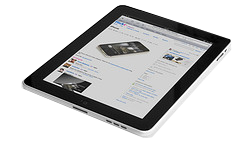 |
|
New York Times app on iPad at launch at San Francisco Apple Store 141 by Steve Rhodes |
I’ve been enjoying some time off last week, mostly just knocking around in my office, filing some old cables away (found two parallel printer cables and an Appletalk adaptor), changing the template on my blog (trying out a three column look), and experimenting with BuddyPress as a replacement for the soon to expire Classblogmeister Ning.
In the process, I’ve been playing around with my old Acer Aspire One (ZG5) netbook — and feel almost sacrilegious in saying this, but I’m finding it to be refreshingly delightful to use, especially for some functions that I have been (admittedly) pushing my iPad to fill. Many have complained that although the iPad would be an excellent consumption device (much better than a textbook), you cannot use it for information production. Others have challenged this suggestion, saying that, “My grandchildren love drawing in my iPad.” I’ve seen some interesting drawing tools for the device with some amazing results. There are many clever and well executed educational games and applications, and with an external keyboard, the iPad makes a descent writing tool. I am, after all, sitting on a sofa and writing (thumbing) this blog post on my iPad.
But the question we have to ask is, “What is the iPad really great at — best at?” My answer, from my experience with the device, is that it is a “great” device to watch.
Of course, if that was all we were going to do with it, we’d have been satisfied with the Kindle. I think that the iPad, as a platform, is amazing, and we certainly haven’t seen the end of its capabilities. I’ve written before that what truly interests me about the device is that “we” will be the ones who discover and invent its place in helping us accomplish our goals. But from an educational point of view, I think that we have to continue to ask, “What is the best technology for the learning experiences we want to craft?”
What’s weak about the iPad, from my point of view, is the OS. It is a wonderful consumer electronic product. It looks good in Best Buy. But I see little indication that formal education was one of the aims in its design. They didn’t build a literacy tool.
So what is a literacy tool. I’ve been thinking about this for a long time, considering how information has changed (as a result of technology) and what that means in terms of essential literacy skills (Redefining Literacy 2.0). I usually describe contemporary literacy by expanding the three “Rs” in a way that accounts for the networked, digital, and abundant (overwhelming) nature of today’s information landscape.
| When information is Networked, Reading | expands into | Exposing what is True (finding, decoding, evaluating, building meaning, etc.) |
| When information is Digital, Arithmetic | expands into | Employing the Information, working the numbers that define all information to add value. |
| When information is abundant (overwhelming), then Writing | expands into | Expressing Ideas Compellingly. Producing a message that competes for the attention of the audience. |
A literacy machine not only enables us to find and read information. But it also facilitates a deeper examination of the information, uncovering the evidence of it’s value, utilizing elements of what Alan November has called “web grammar.” A literacy machine assures that the learner develops the habit of “asking questions about the answers that he finds.”
A literacy machine is also designed to help us work the information, to process not only the massive amounts of digital data that we have access to and need, to make important decisions, but also to be able to process the ones and zeros that now defines almost all information — text, images, sound, video, and animation. A literacy machine empowers, by helping us to realize that content is a raw material, ready to be remixed, shaped, and assembled into the answers of questions, solutions of problems, and the means to accomplish our goals.
Today, communicating requires far more than the ability to write. To compete for the attention of your audience, you must be able to produce a message that effectively conveys your ideas and compellingly draw attention. A literacy machine enables us to communicate, not merely with words, but with pictures, sound, and motion. It enables us to get the attention of those who can help us accomplish our goals.
As I’ve said already, I think that the iPad is an amazing device. It is an information slab with seemingly mystical abilities. And it is exactly the sort of instructional tool that I would like to see all children carrying into their classrooms. But what I would like to see and what is truly the best personal learning device for helping our children to become information artisans, may be two entirely different things.
I would expand yesterday’s final question by asking:
What ICT is going to help my children learn by helping them to become literate, resourceful, and habitual learners — engaged in a learning lifestyle?

Edited on an iMac using MarsEdit

I so agree with your thoughts on the iPad. While I find the device to be compelling, I fear that it fails miserably as a stand-alone device in a school setting. As a long time proponent of a 1:1 environment, I have recognized the advantage that it gives a student is the dramatic change from student as consumer of information to that of producer of information. I fear that a proliferation of iPads in school will move this movement backwards, not forwards.
I agree with what Mr. Warlick said in his post. Even though technology is good and interesting most of the new things are not generally geared toward the educational aspect of the new technology. Most things in this world never change, but technology does change and will change and we must take the leap with it and keep up with our technology. As educators it is up to us to insist that our new technology uses and keeps educational material this should be built in to the technology.
The material is as Mr. Warlick stated, broken into three aspects of the educational world. The reading, writing, and arithmetic of the old days have been transformed into the new ways of technology. We must learn to incorporate the new amounts and correctness of this information we get into our schools and technology. We must also give this new technology time to embrace our lives and hopefully in the years to come we will all be in classes with IPads learning and using them in ways that will surprise even us teachers.
100% agree. Not only Ipad – most techonologies are now aimed at making the life of the searcher, reader, viewer easier – and rare ones concentrate on making the writer’s, or painter’s work go faster. There are lots of applications for this, but no hardware manufacturer actually considers developing in this direction, IMHO. And that’s a pity since after we’ll have “shared” all the existent content, we may feel lack of quality content.
As for implementation for learners, indeed pupils need to have more options to edit and input information, not only swallow it.
Interesting post here. I would have to agree that a devise like the iPod has an incredible amount of potential in regards to classroom implementation. Its interesting that you point out where it is lacking from an educational stand point. I have yet to have the chance to “play” with an iPad myself, but would be curious to check it out. I’m sure that with updates and a re-design some of these issues you mention here will be remedied.
Hello there, I have been searching the internet for a couple of days now and I find your article very interesting so I thought I’d leave you a short note to say what a terrific resource I believe you have going here, carry on the good work.
Visit Tech Edu here